Principles of Marketing: BMW's Branding and International Strategy
VerifiedAdded on 2023/06/13
|22
|5190
|129
Report
AI Summary
This report examines BMW's branding and international marketing strategies, focusing on brand equity models and the glocalization concept. It begins with a background of BMW, including its marketing strategy, marketing mix, and financial performance. The report then analyzes BMW's branding strategy, referencing Keller's and Aaker's brand equity models, and discusses elements such as brand recognition, identity, positioning, personality, and affinity. Furthermore, it delves into BMW's international marketing strategy, exploring reasons for internationalization and the EPRG orientation. The report also discusses the implications for the marketing mix, comparing standardization and adaptation approaches, and critically assesses BMW's marketing mixes based on Hollensen's Glocalization concept. The analysis provides a comprehensive understanding of BMW's branding and international marketing efforts.
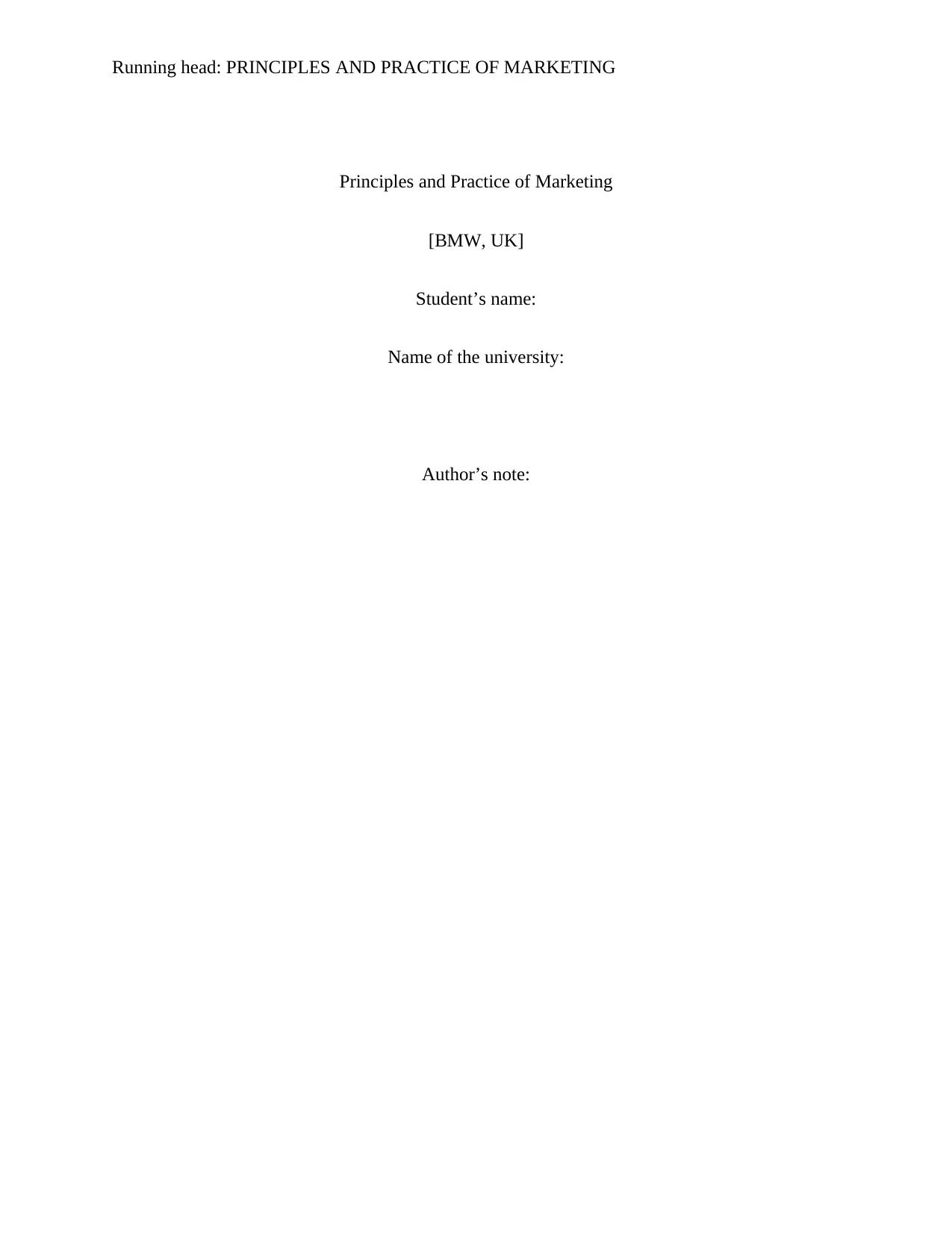
Running head: PRINCIPLES AND PRACTICE OF MARKETING
Principles and Practice of Marketing
[BMW, UK]
Student’s name:
Name of the university:
Author’s note:
Principles and Practice of Marketing
[BMW, UK]
Student’s name:
Name of the university:
Author’s note:
Paraphrase This Document
Need a fresh take? Get an instant paraphrase of this document with our AI Paraphraser
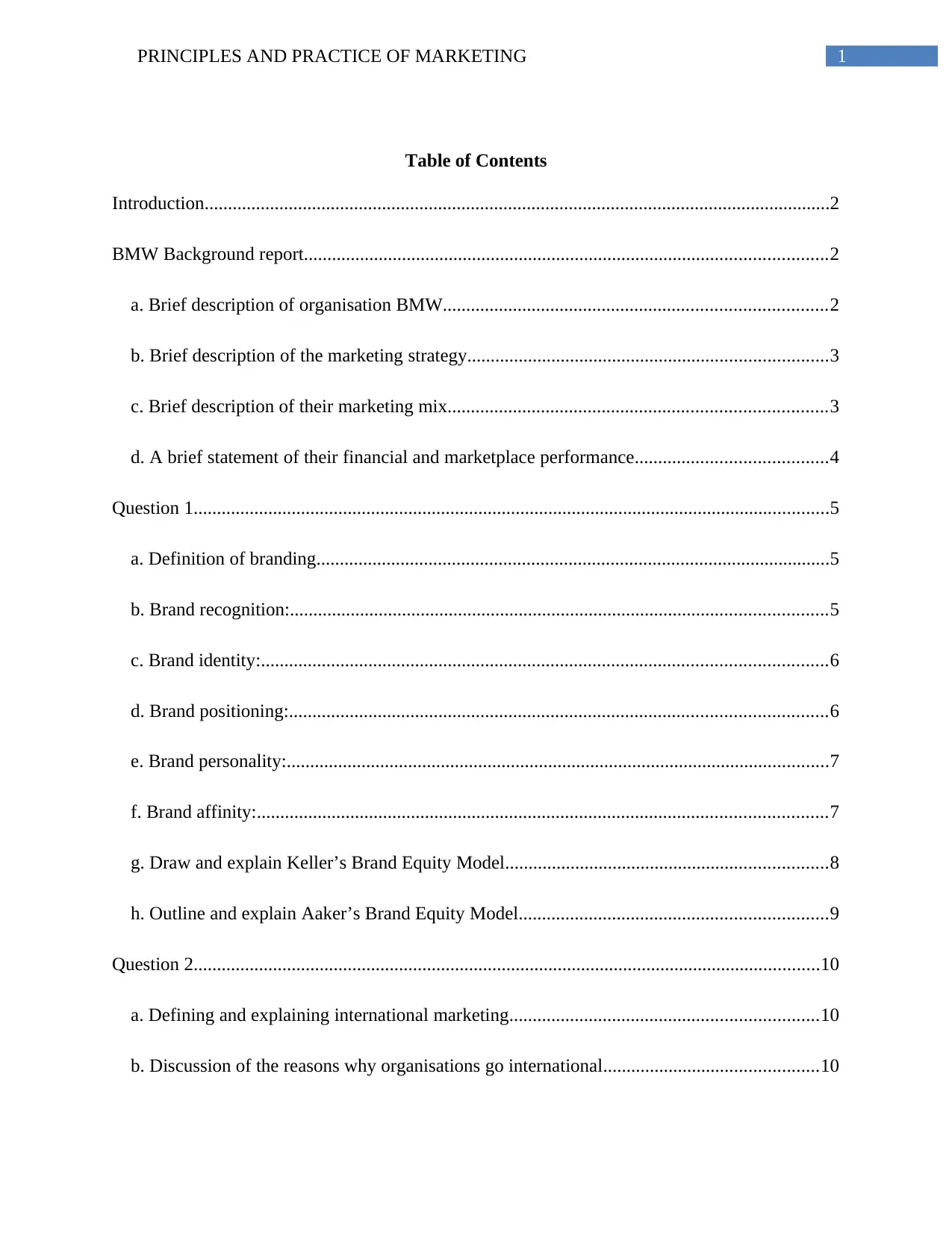
1PRINCIPLES AND PRACTICE OF MARKETING
Table of Contents
Introduction......................................................................................................................................2
BMW Background report................................................................................................................2
a. Brief description of organisation BMW..................................................................................2
b. Brief description of the marketing strategy.............................................................................3
c. Brief description of their marketing mix.................................................................................3
d. A brief statement of their financial and marketplace performance.........................................4
Question 1........................................................................................................................................5
a. Definition of branding..............................................................................................................5
b. Brand recognition:...................................................................................................................5
c. Brand identity:.........................................................................................................................6
d. Brand positioning:...................................................................................................................6
e. Brand personality:....................................................................................................................7
f. Brand affinity:..........................................................................................................................7
g. Draw and explain Keller’s Brand Equity Model.....................................................................8
h. Outline and explain Aaker’s Brand Equity Model..................................................................9
Question 2......................................................................................................................................10
a. Defining and explaining international marketing..................................................................10
b. Discussion of the reasons why organisations go international..............................................10
Table of Contents
Introduction......................................................................................................................................2
BMW Background report................................................................................................................2
a. Brief description of organisation BMW..................................................................................2
b. Brief description of the marketing strategy.............................................................................3
c. Brief description of their marketing mix.................................................................................3
d. A brief statement of their financial and marketplace performance.........................................4
Question 1........................................................................................................................................5
a. Definition of branding..............................................................................................................5
b. Brand recognition:...................................................................................................................5
c. Brand identity:.........................................................................................................................6
d. Brand positioning:...................................................................................................................6
e. Brand personality:....................................................................................................................7
f. Brand affinity:..........................................................................................................................7
g. Draw and explain Keller’s Brand Equity Model.....................................................................8
h. Outline and explain Aaker’s Brand Equity Model..................................................................9
Question 2......................................................................................................................................10
a. Defining and explaining international marketing..................................................................10
b. Discussion of the reasons why organisations go international..............................................10
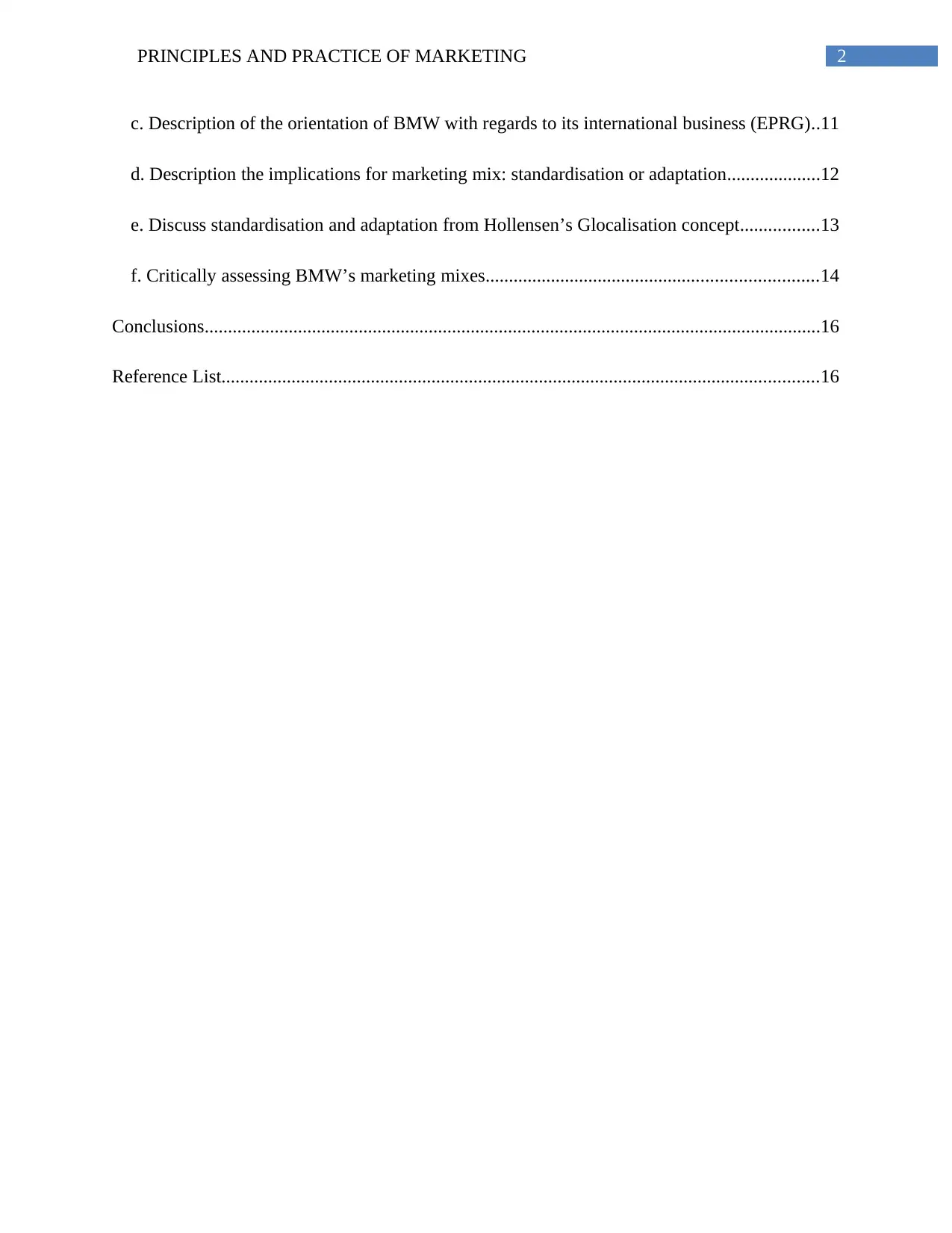
2PRINCIPLES AND PRACTICE OF MARKETING
c. Description of the orientation of BMW with regards to its international business (EPRG)..11
d. Description the implications for marketing mix: standardisation or adaptation....................12
e. Discuss standardisation and adaptation from Hollensen’s Glocalisation concept.................13
f. Critically assessing BMW’s marketing mixes.......................................................................14
Conclusions....................................................................................................................................16
Reference List................................................................................................................................16
c. Description of the orientation of BMW with regards to its international business (EPRG)..11
d. Description the implications for marketing mix: standardisation or adaptation....................12
e. Discuss standardisation and adaptation from Hollensen’s Glocalisation concept.................13
f. Critically assessing BMW’s marketing mixes.......................................................................14
Conclusions....................................................................................................................................16
Reference List................................................................................................................................16
⊘ This is a preview!⊘
Do you want full access?
Subscribe today to unlock all pages.

Trusted by 1+ million students worldwide
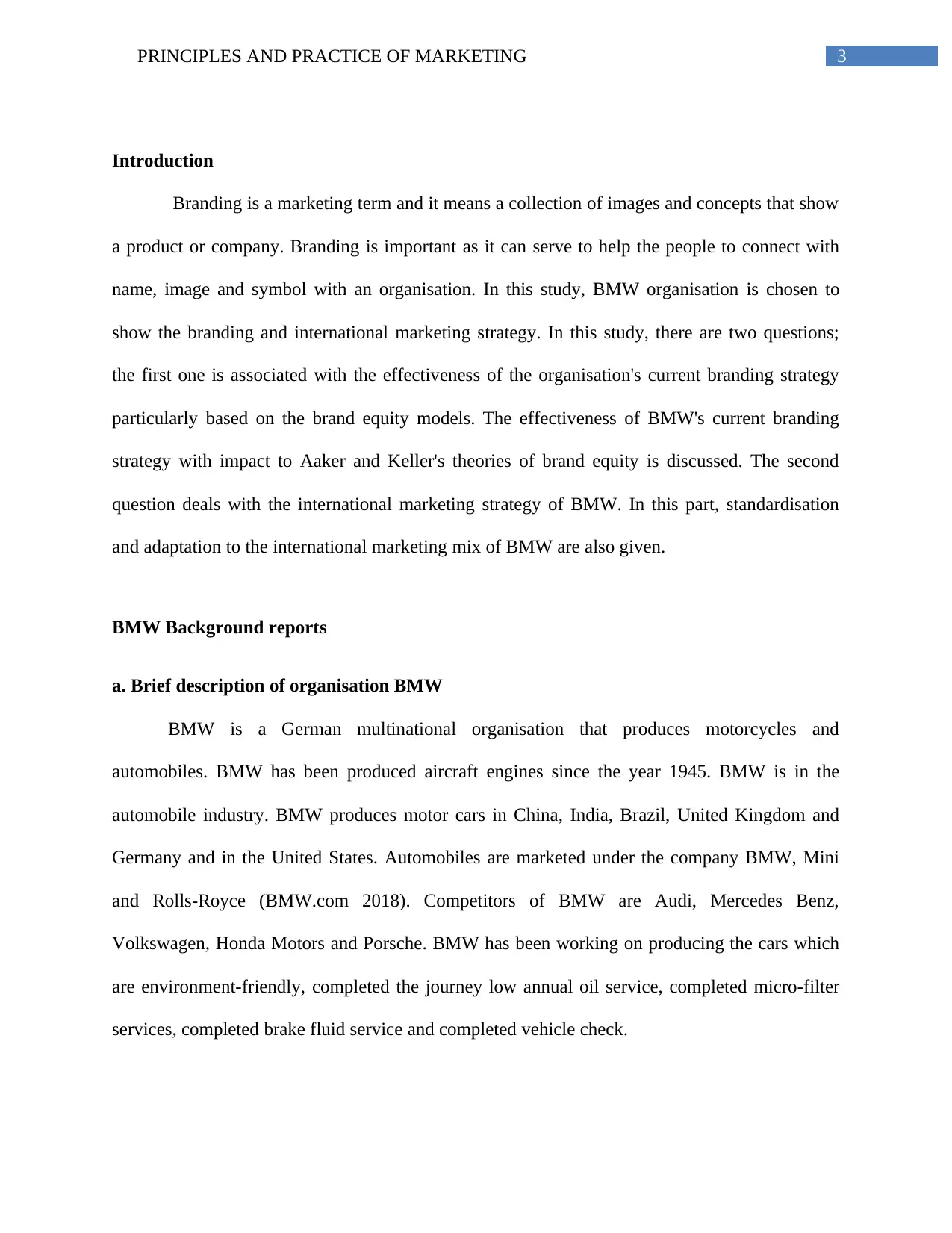
3PRINCIPLES AND PRACTICE OF MARKETING
Introduction
Branding is a marketing term and it means a collection of images and concepts that show
a product or company. Branding is important as it can serve to help the people to connect with
name, image and symbol with an organisation. In this study, BMW organisation is chosen to
show the branding and international marketing strategy. In this study, there are two questions;
the first one is associated with the effectiveness of the organisation's current branding strategy
particularly based on the brand equity models. The effectiveness of BMW's current branding
strategy with impact to Aaker and Keller's theories of brand equity is discussed. The second
question deals with the international marketing strategy of BMW. In this part, standardisation
and adaptation to the international marketing mix of BMW are also given.
BMW Background reports
a. Brief description of organisation BMW
BMW is a German multinational organisation that produces motorcycles and
automobiles. BMW has been produced aircraft engines since the year 1945. BMW is in the
automobile industry. BMW produces motor cars in China, India, Brazil, United Kingdom and
Germany and in the United States. Automobiles are marketed under the company BMW, Mini
and Rolls-Royce (BMW.com 2018). Competitors of BMW are Audi, Mercedes Benz,
Volkswagen, Honda Motors and Porsche. BMW has been working on producing the cars which
are environment-friendly, completed the journey low annual oil service, completed micro-filter
services, completed brake fluid service and completed vehicle check.
Introduction
Branding is a marketing term and it means a collection of images and concepts that show
a product or company. Branding is important as it can serve to help the people to connect with
name, image and symbol with an organisation. In this study, BMW organisation is chosen to
show the branding and international marketing strategy. In this study, there are two questions;
the first one is associated with the effectiveness of the organisation's current branding strategy
particularly based on the brand equity models. The effectiveness of BMW's current branding
strategy with impact to Aaker and Keller's theories of brand equity is discussed. The second
question deals with the international marketing strategy of BMW. In this part, standardisation
and adaptation to the international marketing mix of BMW are also given.
BMW Background reports
a. Brief description of organisation BMW
BMW is a German multinational organisation that produces motorcycles and
automobiles. BMW has been produced aircraft engines since the year 1945. BMW is in the
automobile industry. BMW produces motor cars in China, India, Brazil, United Kingdom and
Germany and in the United States. Automobiles are marketed under the company BMW, Mini
and Rolls-Royce (BMW.com 2018). Competitors of BMW are Audi, Mercedes Benz,
Volkswagen, Honda Motors and Porsche. BMW has been working on producing the cars which
are environment-friendly, completed the journey low annual oil service, completed micro-filter
services, completed brake fluid service and completed vehicle check.
Paraphrase This Document
Need a fresh take? Get an instant paraphrase of this document with our AI Paraphraser
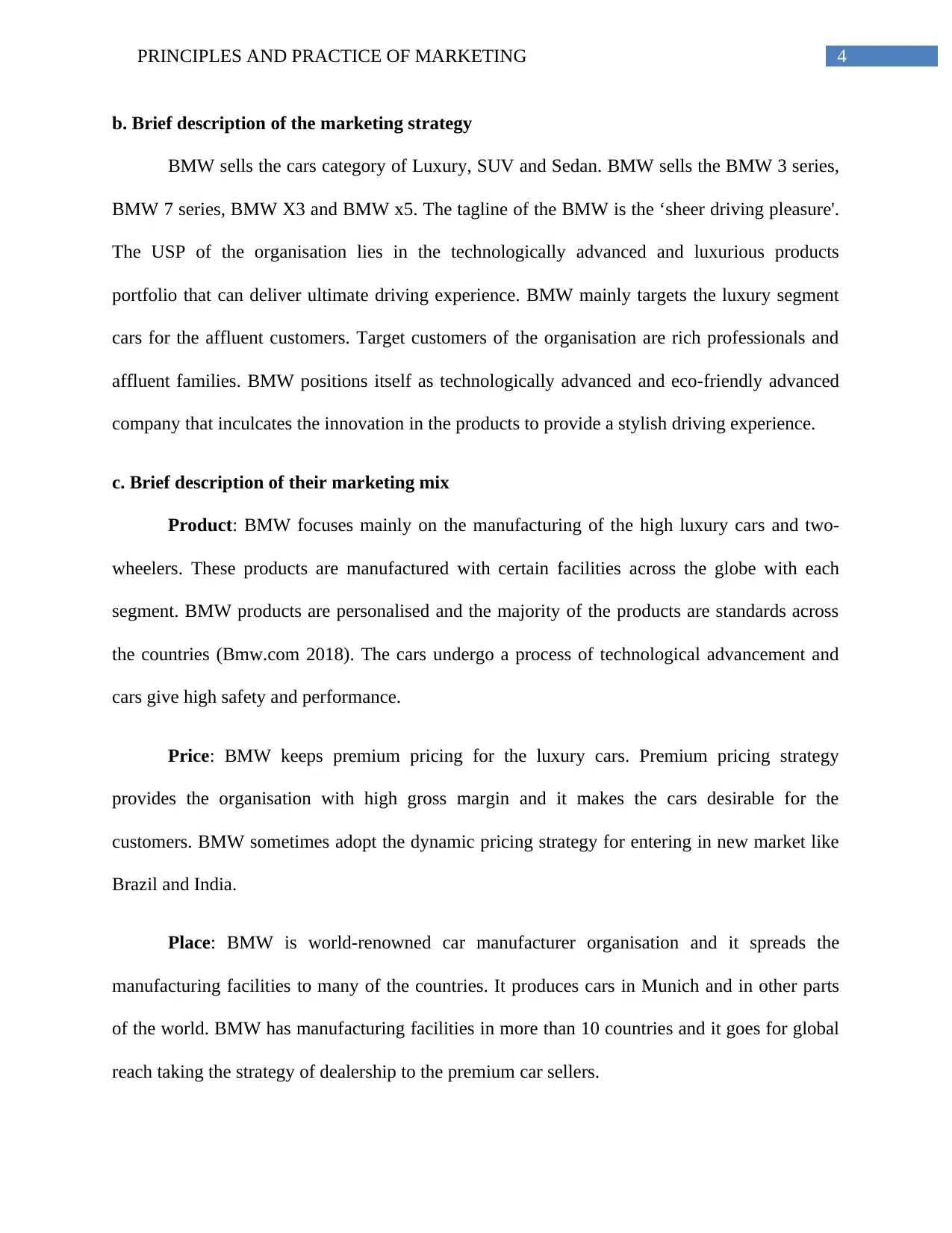
4PRINCIPLES AND PRACTICE OF MARKETING
b. Brief description of the marketing strategy
BMW sells the cars category of Luxury, SUV and Sedan. BMW sells the BMW 3 series,
BMW 7 series, BMW X3 and BMW x5. The tagline of the BMW is the ‘sheer driving pleasure'.
The USP of the organisation lies in the technologically advanced and luxurious products
portfolio that can deliver ultimate driving experience. BMW mainly targets the luxury segment
cars for the affluent customers. Target customers of the organisation are rich professionals and
affluent families. BMW positions itself as technologically advanced and eco-friendly advanced
company that inculcates the innovation in the products to provide a stylish driving experience.
c. Brief description of their marketing mix
Product: BMW focuses mainly on the manufacturing of the high luxury cars and two-
wheelers. These products are manufactured with certain facilities across the globe with each
segment. BMW products are personalised and the majority of the products are standards across
the countries (Bmw.com 2018). The cars undergo a process of technological advancement and
cars give high safety and performance.
Price: BMW keeps premium pricing for the luxury cars. Premium pricing strategy
provides the organisation with high gross margin and it makes the cars desirable for the
customers. BMW sometimes adopt the dynamic pricing strategy for entering in new market like
Brazil and India.
Place: BMW is world-renowned car manufacturer organisation and it spreads the
manufacturing facilities to many of the countries. It produces cars in Munich and in other parts
of the world. BMW has manufacturing facilities in more than 10 countries and it goes for global
reach taking the strategy of dealership to the premium car sellers.
b. Brief description of the marketing strategy
BMW sells the cars category of Luxury, SUV and Sedan. BMW sells the BMW 3 series,
BMW 7 series, BMW X3 and BMW x5. The tagline of the BMW is the ‘sheer driving pleasure'.
The USP of the organisation lies in the technologically advanced and luxurious products
portfolio that can deliver ultimate driving experience. BMW mainly targets the luxury segment
cars for the affluent customers. Target customers of the organisation are rich professionals and
affluent families. BMW positions itself as technologically advanced and eco-friendly advanced
company that inculcates the innovation in the products to provide a stylish driving experience.
c. Brief description of their marketing mix
Product: BMW focuses mainly on the manufacturing of the high luxury cars and two-
wheelers. These products are manufactured with certain facilities across the globe with each
segment. BMW products are personalised and the majority of the products are standards across
the countries (Bmw.com 2018). The cars undergo a process of technological advancement and
cars give high safety and performance.
Price: BMW keeps premium pricing for the luxury cars. Premium pricing strategy
provides the organisation with high gross margin and it makes the cars desirable for the
customers. BMW sometimes adopt the dynamic pricing strategy for entering in new market like
Brazil and India.
Place: BMW is world-renowned car manufacturer organisation and it spreads the
manufacturing facilities to many of the countries. It produces cars in Munich and in other parts
of the world. BMW has manufacturing facilities in more than 10 countries and it goes for global
reach taking the strategy of dealership to the premium car sellers.
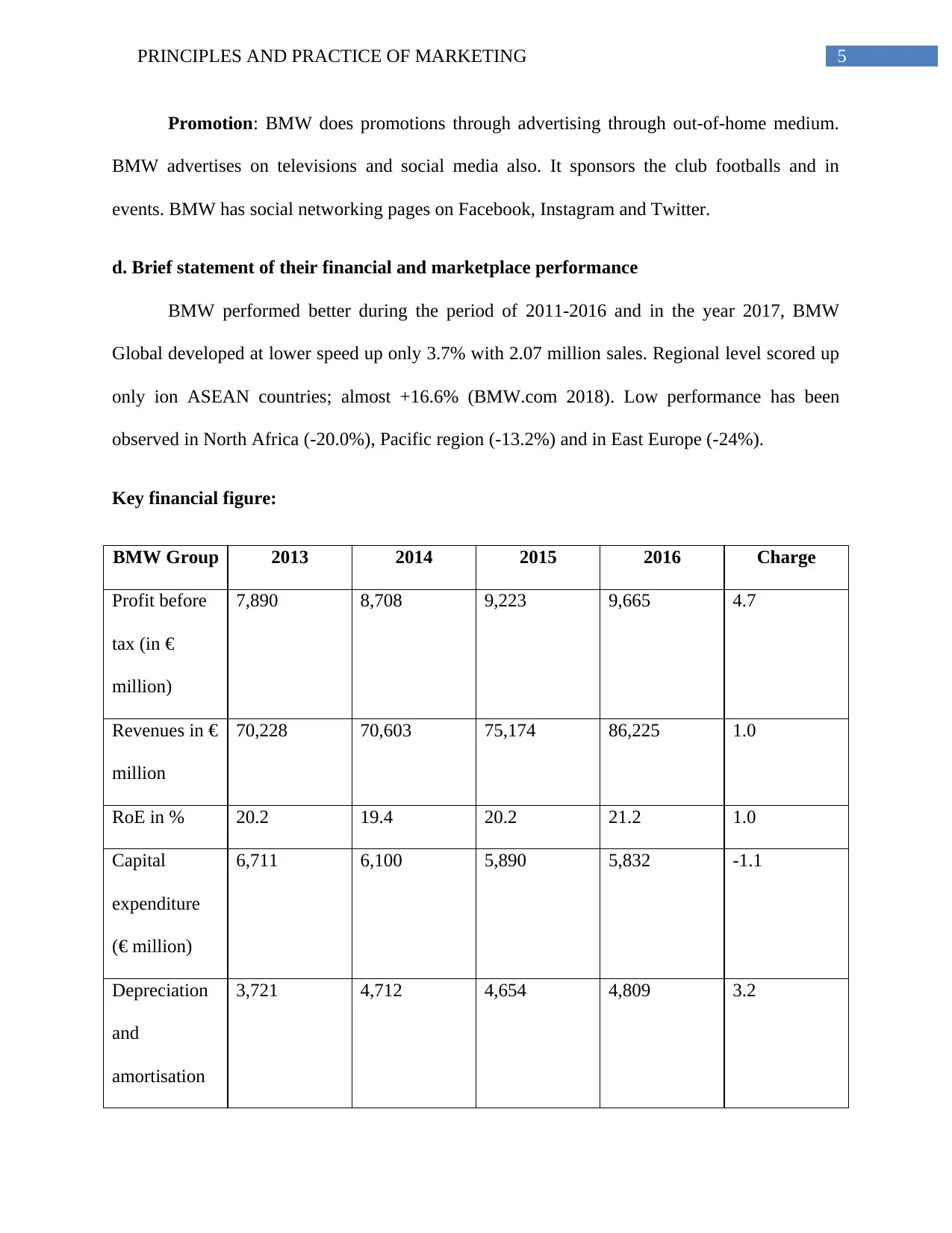
5PRINCIPLES AND PRACTICE OF MARKETING
Promotion: BMW does promotions through advertising through out-of-home medium.
BMW advertises on televisions and social media also. It sponsors the club footballs and in
events. BMW has social networking pages on Facebook, Instagram and Twitter.
d. Brief statement of their financial and marketplace performance
BMW performed better during the period of 2011-2016 and in the year 2017, BMW
Global developed at lower speed up only 3.7% with 2.07 million sales. Regional level scored up
only ion ASEAN countries; almost +16.6% (BMW.com 2018). Low performance has been
observed in North Africa (-20.0%), Pacific region (-13.2%) and in East Europe (-24%).
Key financial figure:
BMW Group 2013 2014 2015 2016 Charge
Profit before
tax (in €
million)
7,890 8,708 9,223 9,665 4.7
Revenues in €
million
70,228 70,603 75,174 86,225 1.0
RoE in % 20.2 19.4 20.2 21.2 1.0
Capital
expenditure
(€ million)
6,711 6,100 5,890 5,832 -1.1
Depreciation
and
amortisation
3,721 4,712 4,654 4,809 3.2
Promotion: BMW does promotions through advertising through out-of-home medium.
BMW advertises on televisions and social media also. It sponsors the club footballs and in
events. BMW has social networking pages on Facebook, Instagram and Twitter.
d. Brief statement of their financial and marketplace performance
BMW performed better during the period of 2011-2016 and in the year 2017, BMW
Global developed at lower speed up only 3.7% with 2.07 million sales. Regional level scored up
only ion ASEAN countries; almost +16.6% (BMW.com 2018). Low performance has been
observed in North Africa (-20.0%), Pacific region (-13.2%) and in East Europe (-24%).
Key financial figure:
BMW Group 2013 2014 2015 2016 Charge
Profit before
tax (in €
million)
7,890 8,708 9,223 9,665 4.7
Revenues in €
million
70,228 70,603 75,174 86,225 1.0
RoE in % 20.2 19.4 20.2 21.2 1.0
Capital
expenditure
(€ million)
6,711 6,100 5,890 5,832 -1.1
Depreciation
and
amortisation
3,721 4,712 4,654 4,809 3.2
⊘ This is a preview!⊘
Do you want full access?
Subscribe today to unlock all pages.

Trusted by 1+ million students worldwide
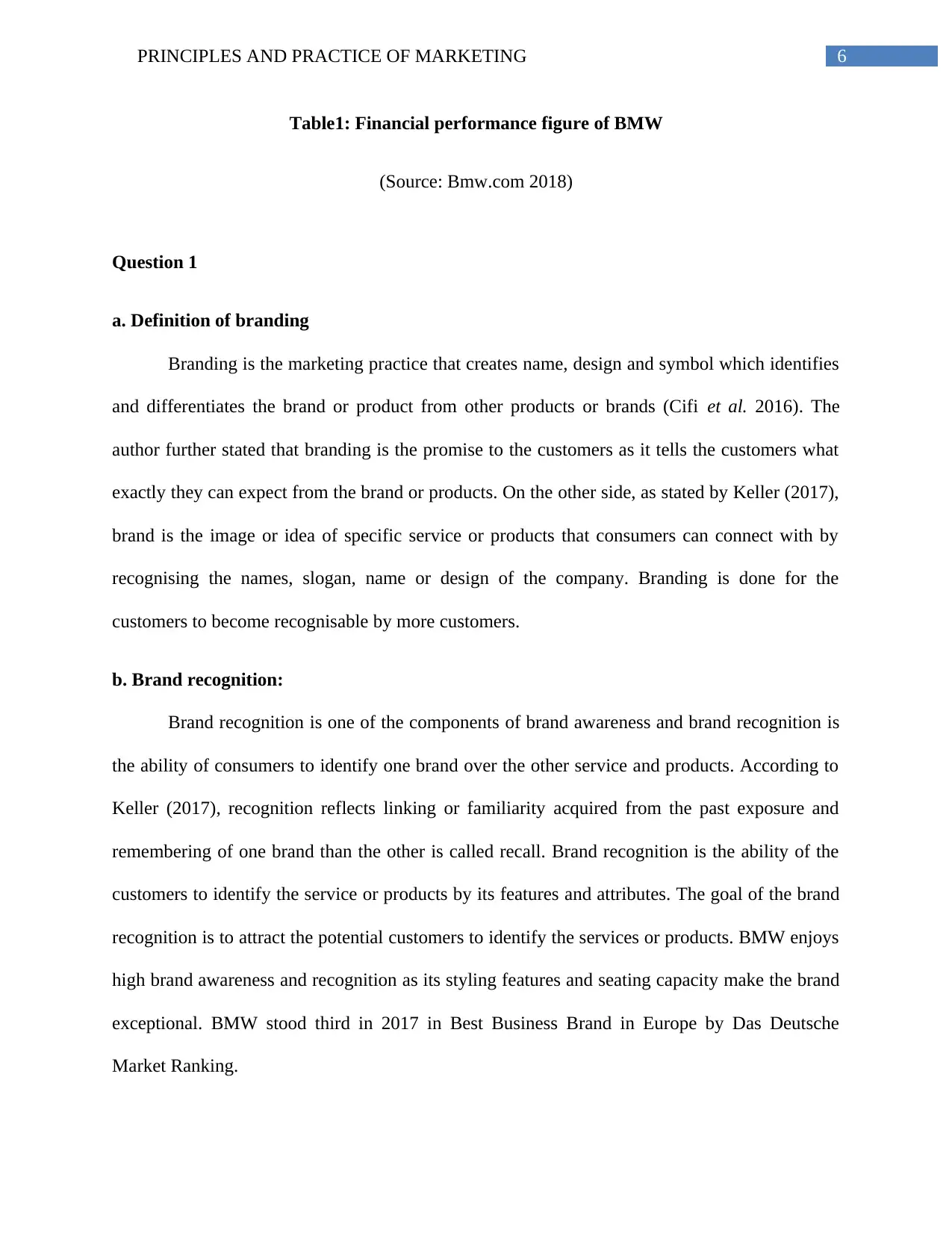
6PRINCIPLES AND PRACTICE OF MARKETING
Table1: Financial performance figure of BMW
(Source: Bmw.com 2018)
Question 1
a. Definition of branding
Branding is the marketing practice that creates name, design and symbol which identifies
and differentiates the brand or product from other products or brands (Cifi et al. 2016). The
author further stated that branding is the promise to the customers as it tells the customers what
exactly they can expect from the brand or products. On the other side, as stated by Keller (2017),
brand is the image or idea of specific service or products that consumers can connect with by
recognising the names, slogan, name or design of the company. Branding is done for the
customers to become recognisable by more customers.
b. Brand recognition:
Brand recognition is one of the components of brand awareness and brand recognition is
the ability of consumers to identify one brand over the other service and products. According to
Keller (2017), recognition reflects linking or familiarity acquired from the past exposure and
remembering of one brand than the other is called recall. Brand recognition is the ability of the
customers to identify the service or products by its features and attributes. The goal of the brand
recognition is to attract the potential customers to identify the services or products. BMW enjoys
high brand awareness and recognition as its styling features and seating capacity make the brand
exceptional. BMW stood third in 2017 in Best Business Brand in Europe by Das Deutsche
Market Ranking.
Table1: Financial performance figure of BMW
(Source: Bmw.com 2018)
Question 1
a. Definition of branding
Branding is the marketing practice that creates name, design and symbol which identifies
and differentiates the brand or product from other products or brands (Cifi et al. 2016). The
author further stated that branding is the promise to the customers as it tells the customers what
exactly they can expect from the brand or products. On the other side, as stated by Keller (2017),
brand is the image or idea of specific service or products that consumers can connect with by
recognising the names, slogan, name or design of the company. Branding is done for the
customers to become recognisable by more customers.
b. Brand recognition:
Brand recognition is one of the components of brand awareness and brand recognition is
the ability of consumers to identify one brand over the other service and products. According to
Keller (2017), recognition reflects linking or familiarity acquired from the past exposure and
remembering of one brand than the other is called recall. Brand recognition is the ability of the
customers to identify the service or products by its features and attributes. The goal of the brand
recognition is to attract the potential customers to identify the services or products. BMW enjoys
high brand awareness and recognition as its styling features and seating capacity make the brand
exceptional. BMW stood third in 2017 in Best Business Brand in Europe by Das Deutsche
Market Ranking.
Paraphrase This Document
Need a fresh take? Get an instant paraphrase of this document with our AI Paraphraser
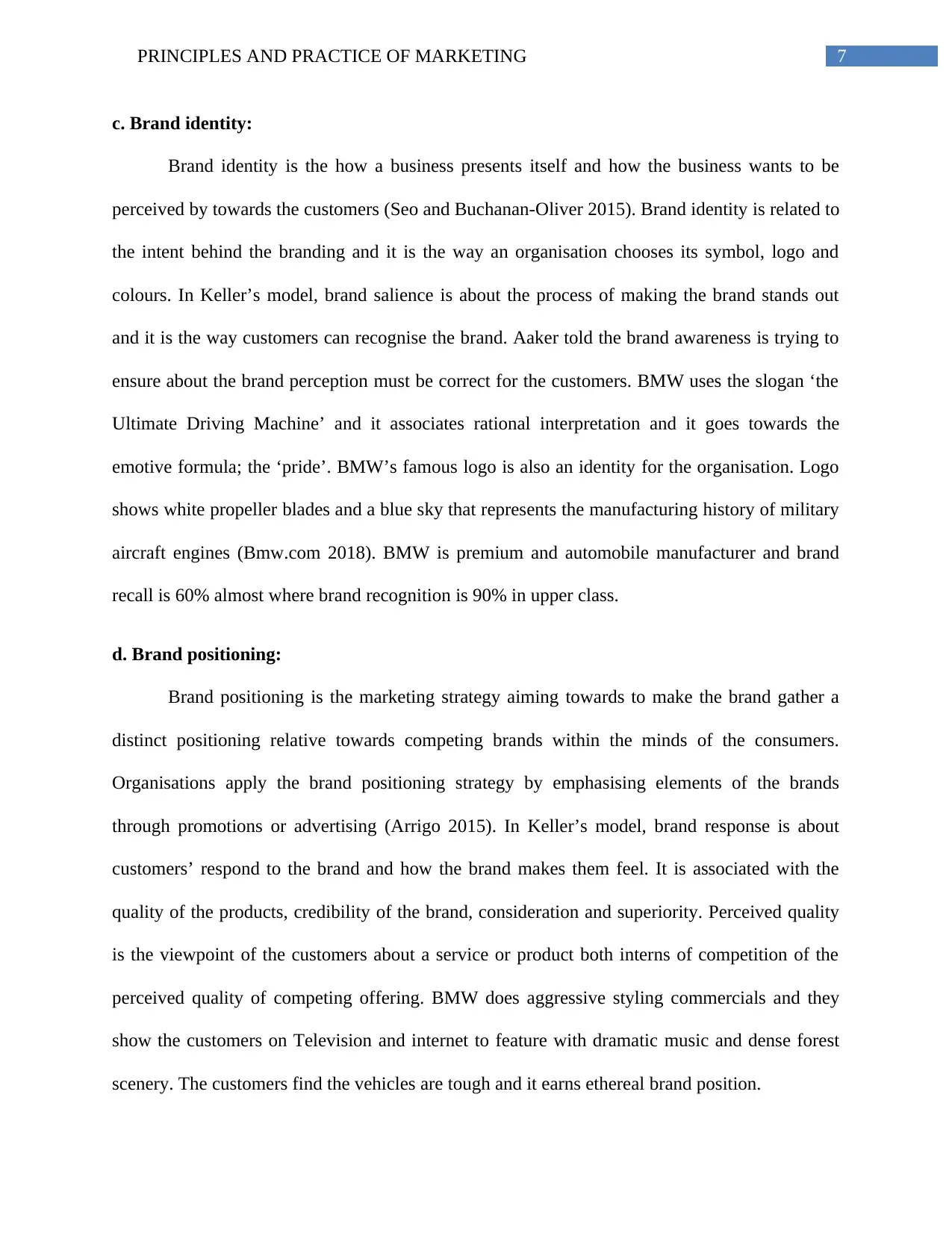
7PRINCIPLES AND PRACTICE OF MARKETING
c. Brand identity:
Brand identity is the how a business presents itself and how the business wants to be
perceived by towards the customers (Seo and Buchanan-Oliver 2015). Brand identity is related to
the intent behind the branding and it is the way an organisation chooses its symbol, logo and
colours. In Keller’s model, brand salience is about the process of making the brand stands out
and it is the way customers can recognise the brand. Aaker told the brand awareness is trying to
ensure about the brand perception must be correct for the customers. BMW uses the slogan ‘the
Ultimate Driving Machine’ and it associates rational interpretation and it goes towards the
emotive formula; the ‘pride’. BMW’s famous logo is also an identity for the organisation. Logo
shows white propeller blades and a blue sky that represents the manufacturing history of military
aircraft engines (Bmw.com 2018). BMW is premium and automobile manufacturer and brand
recall is 60% almost where brand recognition is 90% in upper class.
d. Brand positioning:
Brand positioning is the marketing strategy aiming towards to make the brand gather a
distinct positioning relative towards competing brands within the minds of the consumers.
Organisations apply the brand positioning strategy by emphasising elements of the brands
through promotions or advertising (Arrigo 2015). In Keller’s model, brand response is about
customers’ respond to the brand and how the brand makes them feel. It is associated with the
quality of the products, credibility of the brand, consideration and superiority. Perceived quality
is the viewpoint of the customers about a service or product both interns of competition of the
perceived quality of competing offering. BMW does aggressive styling commercials and they
show the customers on Television and internet to feature with dramatic music and dense forest
scenery. The customers find the vehicles are tough and it earns ethereal brand position.
c. Brand identity:
Brand identity is the how a business presents itself and how the business wants to be
perceived by towards the customers (Seo and Buchanan-Oliver 2015). Brand identity is related to
the intent behind the branding and it is the way an organisation chooses its symbol, logo and
colours. In Keller’s model, brand salience is about the process of making the brand stands out
and it is the way customers can recognise the brand. Aaker told the brand awareness is trying to
ensure about the brand perception must be correct for the customers. BMW uses the slogan ‘the
Ultimate Driving Machine’ and it associates rational interpretation and it goes towards the
emotive formula; the ‘pride’. BMW’s famous logo is also an identity for the organisation. Logo
shows white propeller blades and a blue sky that represents the manufacturing history of military
aircraft engines (Bmw.com 2018). BMW is premium and automobile manufacturer and brand
recall is 60% almost where brand recognition is 90% in upper class.
d. Brand positioning:
Brand positioning is the marketing strategy aiming towards to make the brand gather a
distinct positioning relative towards competing brands within the minds of the consumers.
Organisations apply the brand positioning strategy by emphasising elements of the brands
through promotions or advertising (Arrigo 2015). In Keller’s model, brand response is about
customers’ respond to the brand and how the brand makes them feel. It is associated with the
quality of the products, credibility of the brand, consideration and superiority. Perceived quality
is the viewpoint of the customers about a service or product both interns of competition of the
perceived quality of competing offering. BMW does aggressive styling commercials and they
show the customers on Television and internet to feature with dramatic music and dense forest
scenery. The customers find the vehicles are tough and it earns ethereal brand position.
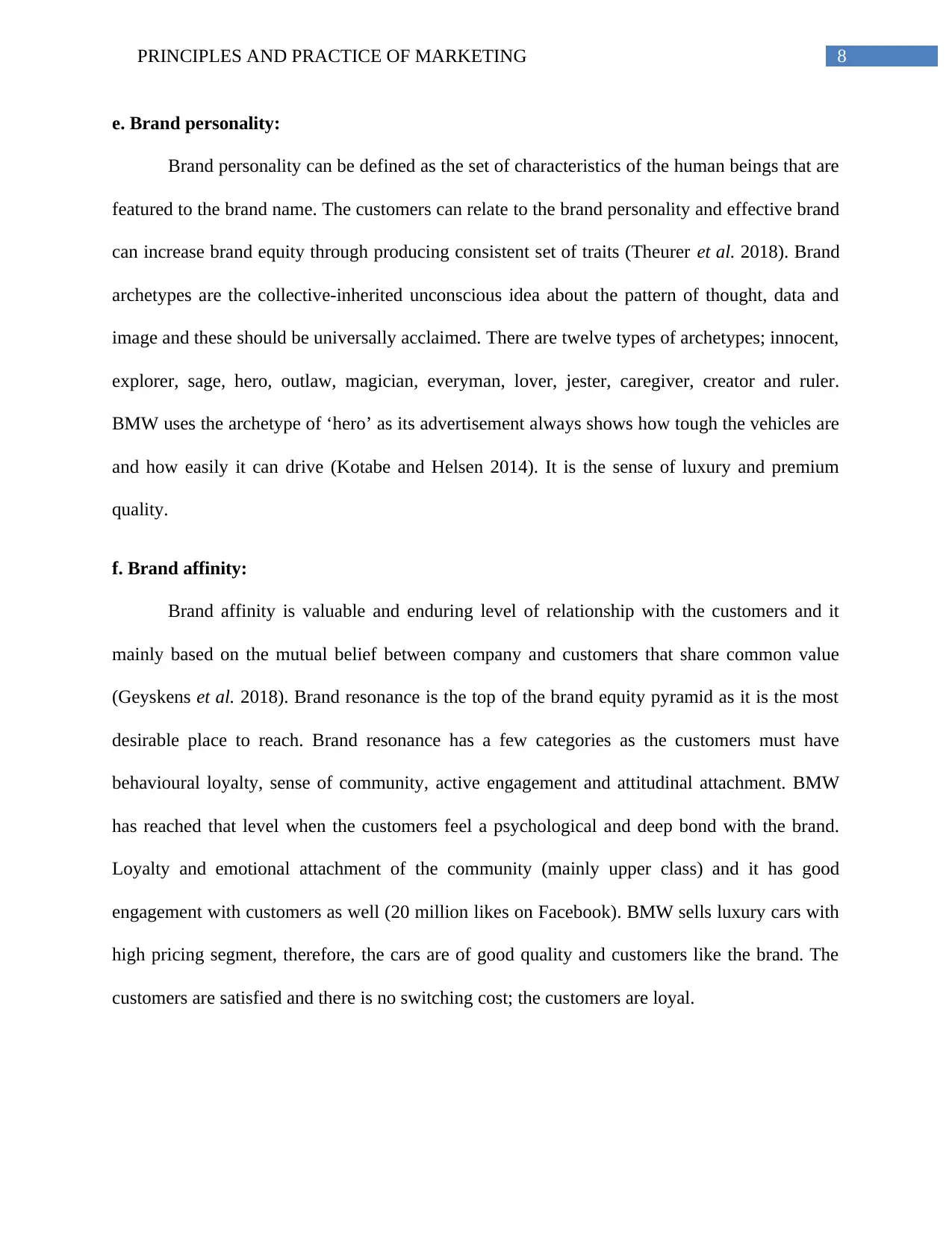
8PRINCIPLES AND PRACTICE OF MARKETING
e. Brand personality:
Brand personality can be defined as the set of characteristics of the human beings that are
featured to the brand name. The customers can relate to the brand personality and effective brand
can increase brand equity through producing consistent set of traits (Theurer et al. 2018). Brand
archetypes are the collective-inherited unconscious idea about the pattern of thought, data and
image and these should be universally acclaimed. There are twelve types of archetypes; innocent,
explorer, sage, hero, outlaw, magician, everyman, lover, jester, caregiver, creator and ruler.
BMW uses the archetype of ‘hero’ as its advertisement always shows how tough the vehicles are
and how easily it can drive (Kotabe and Helsen 2014). It is the sense of luxury and premium
quality.
f. Brand affinity:
Brand affinity is valuable and enduring level of relationship with the customers and it
mainly based on the mutual belief between company and customers that share common value
(Geyskens et al. 2018). Brand resonance is the top of the brand equity pyramid as it is the most
desirable place to reach. Brand resonance has a few categories as the customers must have
behavioural loyalty, sense of community, active engagement and attitudinal attachment. BMW
has reached that level when the customers feel a psychological and deep bond with the brand.
Loyalty and emotional attachment of the community (mainly upper class) and it has good
engagement with customers as well (20 million likes on Facebook). BMW sells luxury cars with
high pricing segment, therefore, the cars are of good quality and customers like the brand. The
customers are satisfied and there is no switching cost; the customers are loyal.
e. Brand personality:
Brand personality can be defined as the set of characteristics of the human beings that are
featured to the brand name. The customers can relate to the brand personality and effective brand
can increase brand equity through producing consistent set of traits (Theurer et al. 2018). Brand
archetypes are the collective-inherited unconscious idea about the pattern of thought, data and
image and these should be universally acclaimed. There are twelve types of archetypes; innocent,
explorer, sage, hero, outlaw, magician, everyman, lover, jester, caregiver, creator and ruler.
BMW uses the archetype of ‘hero’ as its advertisement always shows how tough the vehicles are
and how easily it can drive (Kotabe and Helsen 2014). It is the sense of luxury and premium
quality.
f. Brand affinity:
Brand affinity is valuable and enduring level of relationship with the customers and it
mainly based on the mutual belief between company and customers that share common value
(Geyskens et al. 2018). Brand resonance is the top of the brand equity pyramid as it is the most
desirable place to reach. Brand resonance has a few categories as the customers must have
behavioural loyalty, sense of community, active engagement and attitudinal attachment. BMW
has reached that level when the customers feel a psychological and deep bond with the brand.
Loyalty and emotional attachment of the community (mainly upper class) and it has good
engagement with customers as well (20 million likes on Facebook). BMW sells luxury cars with
high pricing segment, therefore, the cars are of good quality and customers like the brand. The
customers are satisfied and there is no switching cost; the customers are loyal.
⊘ This is a preview!⊘
Do you want full access?
Subscribe today to unlock all pages.

Trusted by 1+ million students worldwide
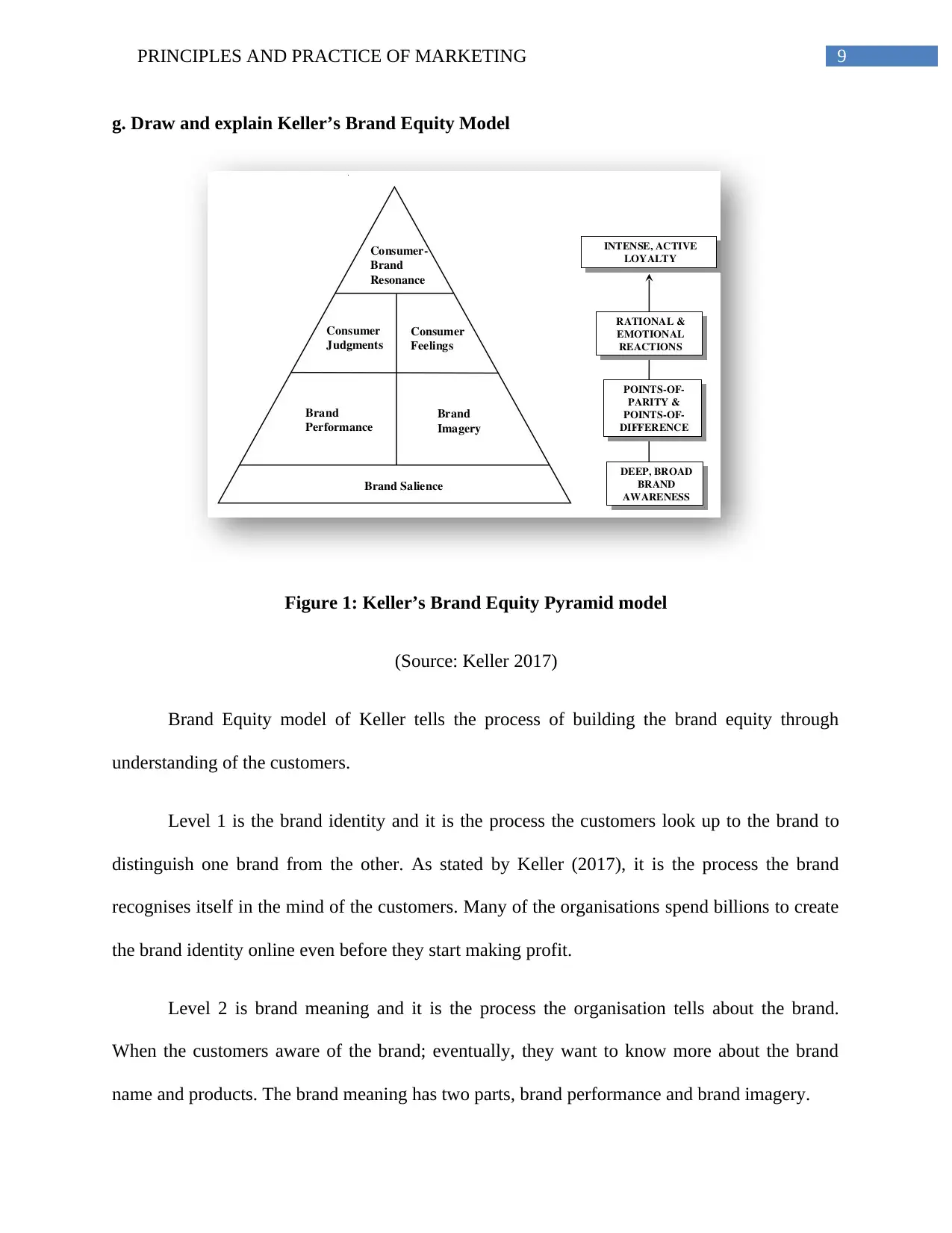
9PRINCIPLES AND PRACTICE OF MARKETING
g. Draw and explain Keller’s Brand Equity Model
Figure 1: Keller’s Brand Equity Pyramid model
(Source: Keller 2017)
Brand Equity model of Keller tells the process of building the brand equity through
understanding of the customers.
Level 1 is the brand identity and it is the process the customers look up to the brand to
distinguish one brand from the other. As stated by Keller (2017), it is the process the brand
recognises itself in the mind of the customers. Many of the organisations spend billions to create
the brand identity online even before they start making profit.
Level 2 is brand meaning and it is the process the organisation tells about the brand.
When the customers aware of the brand; eventually, they want to know more about the brand
name and products. The brand meaning has two parts, brand performance and brand imagery.
g. Draw and explain Keller’s Brand Equity Model
Figure 1: Keller’s Brand Equity Pyramid model
(Source: Keller 2017)
Brand Equity model of Keller tells the process of building the brand equity through
understanding of the customers.
Level 1 is the brand identity and it is the process the customers look up to the brand to
distinguish one brand from the other. As stated by Keller (2017), it is the process the brand
recognises itself in the mind of the customers. Many of the organisations spend billions to create
the brand identity online even before they start making profit.
Level 2 is brand meaning and it is the process the organisation tells about the brand.
When the customers aware of the brand; eventually, they want to know more about the brand
name and products. The brand meaning has two parts, brand performance and brand imagery.
Paraphrase This Document
Need a fresh take? Get an instant paraphrase of this document with our AI Paraphraser
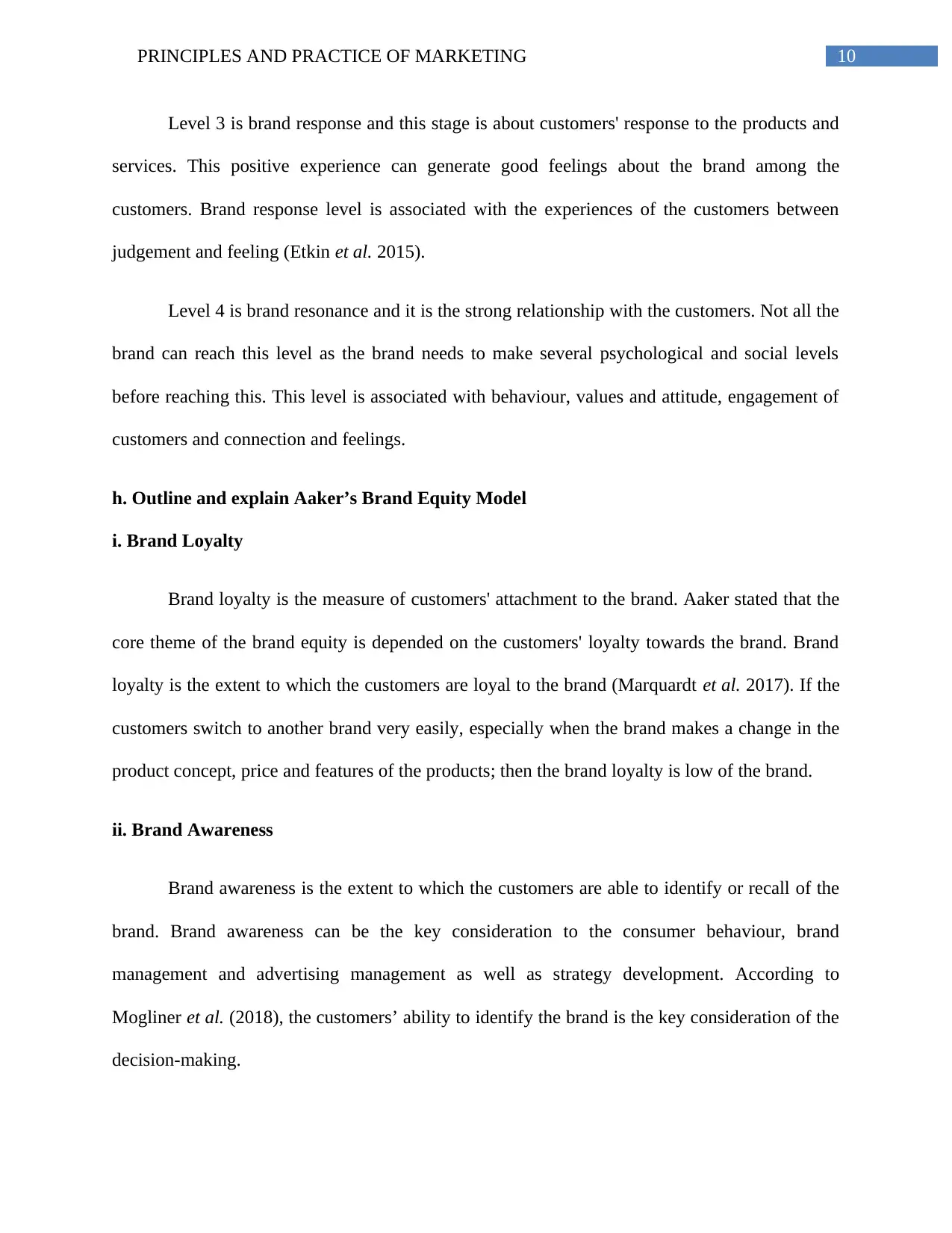
10PRINCIPLES AND PRACTICE OF MARKETING
Level 3 is brand response and this stage is about customers' response to the products and
services. This positive experience can generate good feelings about the brand among the
customers. Brand response level is associated with the experiences of the customers between
judgement and feeling (Etkin et al. 2015).
Level 4 is brand resonance and it is the strong relationship with the customers. Not all the
brand can reach this level as the brand needs to make several psychological and social levels
before reaching this. This level is associated with behaviour, values and attitude, engagement of
customers and connection and feelings.
h. Outline and explain Aaker’s Brand Equity Model
i. Brand Loyalty
Brand loyalty is the measure of customers' attachment to the brand. Aaker stated that the
core theme of the brand equity is depended on the customers' loyalty towards the brand. Brand
loyalty is the extent to which the customers are loyal to the brand (Marquardt et al. 2017). If the
customers switch to another brand very easily, especially when the brand makes a change in the
product concept, price and features of the products; then the brand loyalty is low of the brand.
ii. Brand Awareness
Brand awareness is the extent to which the customers are able to identify or recall of the
brand. Brand awareness can be the key consideration to the consumer behaviour, brand
management and advertising management as well as strategy development. According to
Mogliner et al. (2018), the customers’ ability to identify the brand is the key consideration of the
decision-making.
Level 3 is brand response and this stage is about customers' response to the products and
services. This positive experience can generate good feelings about the brand among the
customers. Brand response level is associated with the experiences of the customers between
judgement and feeling (Etkin et al. 2015).
Level 4 is brand resonance and it is the strong relationship with the customers. Not all the
brand can reach this level as the brand needs to make several psychological and social levels
before reaching this. This level is associated with behaviour, values and attitude, engagement of
customers and connection and feelings.
h. Outline and explain Aaker’s Brand Equity Model
i. Brand Loyalty
Brand loyalty is the measure of customers' attachment to the brand. Aaker stated that the
core theme of the brand equity is depended on the customers' loyalty towards the brand. Brand
loyalty is the extent to which the customers are loyal to the brand (Marquardt et al. 2017). If the
customers switch to another brand very easily, especially when the brand makes a change in the
product concept, price and features of the products; then the brand loyalty is low of the brand.
ii. Brand Awareness
Brand awareness is the extent to which the customers are able to identify or recall of the
brand. Brand awareness can be the key consideration to the consumer behaviour, brand
management and advertising management as well as strategy development. According to
Mogliner et al. (2018), the customers’ ability to identify the brand is the key consideration of the
decision-making.
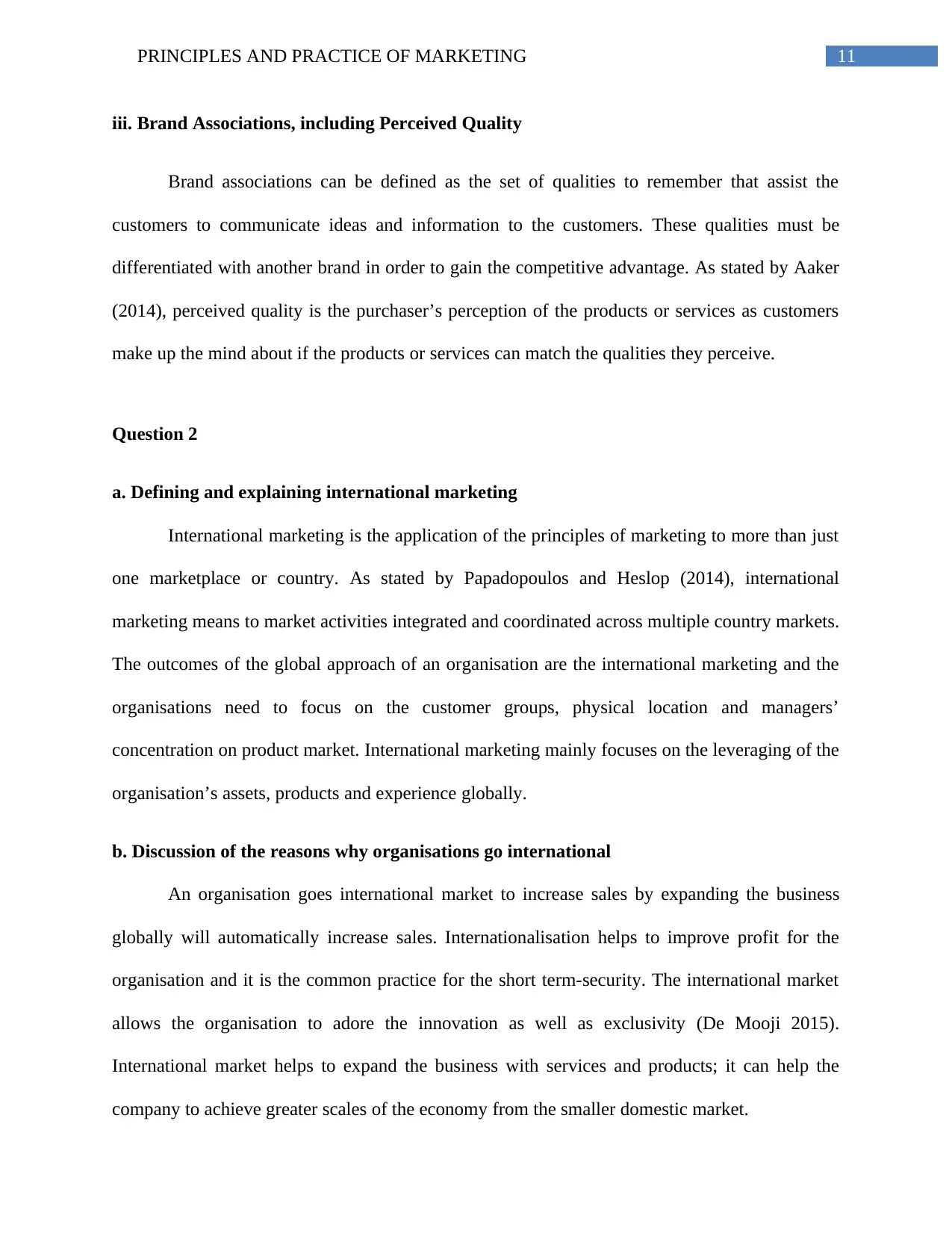
11PRINCIPLES AND PRACTICE OF MARKETING
iii. Brand Associations, including Perceived Quality
Brand associations can be defined as the set of qualities to remember that assist the
customers to communicate ideas and information to the customers. These qualities must be
differentiated with another brand in order to gain the competitive advantage. As stated by Aaker
(2014), perceived quality is the purchaser’s perception of the products or services as customers
make up the mind about if the products or services can match the qualities they perceive.
Question 2
a. Defining and explaining international marketing
International marketing is the application of the principles of marketing to more than just
one marketplace or country. As stated by Papadopoulos and Heslop (2014), international
marketing means to market activities integrated and coordinated across multiple country markets.
The outcomes of the global approach of an organisation are the international marketing and the
organisations need to focus on the customer groups, physical location and managers’
concentration on product market. International marketing mainly focuses on the leveraging of the
organisation’s assets, products and experience globally.
b. Discussion of the reasons why organisations go international
An organisation goes international market to increase sales by expanding the business
globally will automatically increase sales. Internationalisation helps to improve profit for the
organisation and it is the common practice for the short term-security. The international market
allows the organisation to adore the innovation as well as exclusivity (De Mooji 2015).
International market helps to expand the business with services and products; it can help the
company to achieve greater scales of the economy from the smaller domestic market.
iii. Brand Associations, including Perceived Quality
Brand associations can be defined as the set of qualities to remember that assist the
customers to communicate ideas and information to the customers. These qualities must be
differentiated with another brand in order to gain the competitive advantage. As stated by Aaker
(2014), perceived quality is the purchaser’s perception of the products or services as customers
make up the mind about if the products or services can match the qualities they perceive.
Question 2
a. Defining and explaining international marketing
International marketing is the application of the principles of marketing to more than just
one marketplace or country. As stated by Papadopoulos and Heslop (2014), international
marketing means to market activities integrated and coordinated across multiple country markets.
The outcomes of the global approach of an organisation are the international marketing and the
organisations need to focus on the customer groups, physical location and managers’
concentration on product market. International marketing mainly focuses on the leveraging of the
organisation’s assets, products and experience globally.
b. Discussion of the reasons why organisations go international
An organisation goes international market to increase sales by expanding the business
globally will automatically increase sales. Internationalisation helps to improve profit for the
organisation and it is the common practice for the short term-security. The international market
allows the organisation to adore the innovation as well as exclusivity (De Mooji 2015).
International market helps to expand the business with services and products; it can help the
company to achieve greater scales of the economy from the smaller domestic market.
⊘ This is a preview!⊘
Do you want full access?
Subscribe today to unlock all pages.

Trusted by 1+ million students worldwide
1 out of 22
Related Documents
Your All-in-One AI-Powered Toolkit for Academic Success.
+13062052269
info@desklib.com
Available 24*7 on WhatsApp / Email
![[object Object]](/_next/static/media/star-bottom.7253800d.svg)
Unlock your academic potential
Copyright © 2020–2025 A2Z Services. All Rights Reserved. Developed and managed by ZUCOL.




